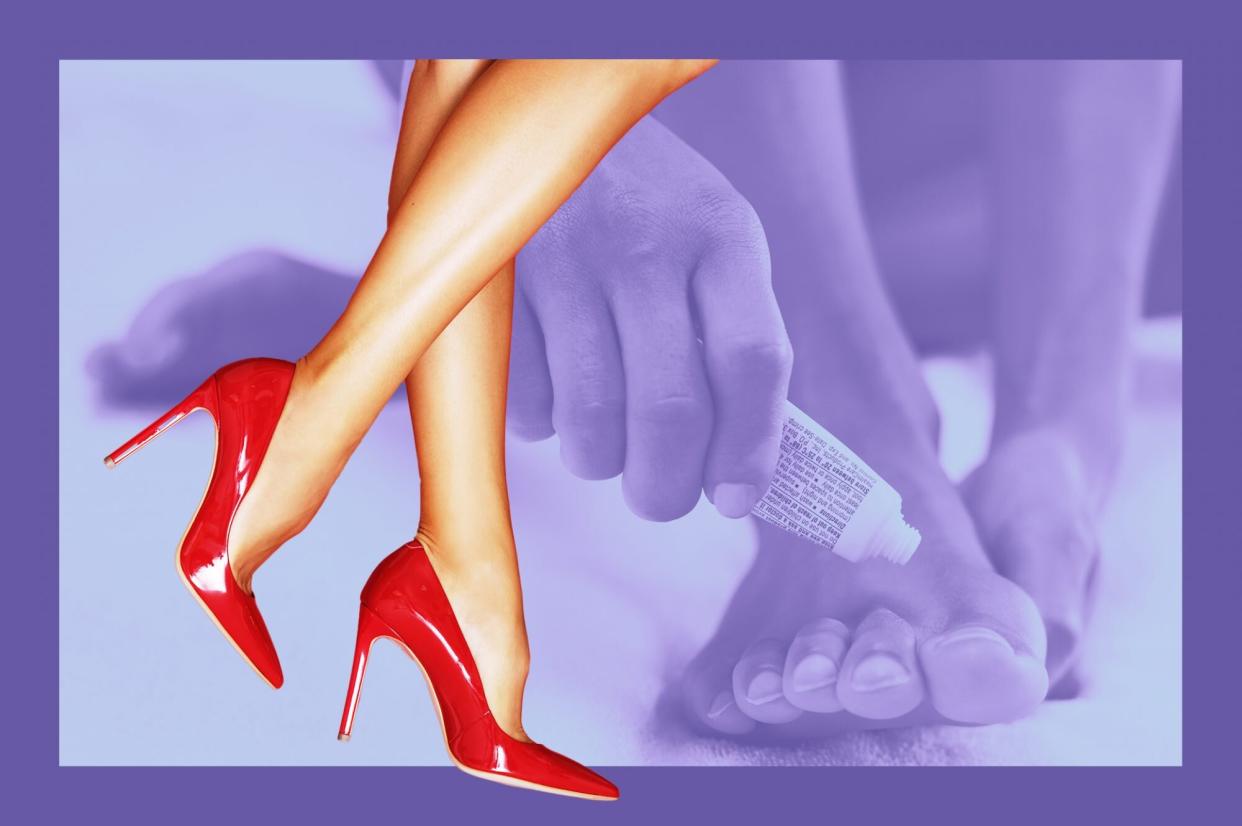TikTok Users Say Spraying Your Feet with Lidocaine Makes Wearing High Heels Comfortable — But Is It Safe?

Getty Images
With the return of fancy events and evenings out with friends, there's a possibility you could be dusting off your favorite pair of pre-pandemic heels from the back of your closet in the future. But with that, however, comes the possibility of pain you may experience from standing or walking in high heels for hours on end. (ICYDK, it's not just heels — other accessories can also hurt your body.)
Unsurprisingly, there's already a TikTok hack floating around that seemingly illustrates how to eliminate the discomfort that comes from wearing high heels. Recently, TikTok user @ChristyClips revealed that the "secret" to wearing heels for more than six hours is by spraying Aspercreme pain relief (Buy It, $9, amazon.com), which includes 4 percent lidocaine (a topical anesthetic), all over the feet. The August 2021 clip has since gone viral (it's racked up nearly 19 million views as of Tuesday) and has prompted others to give the hack a whirl as well.
Now, if you're wondering how a spray designed to relieve muscle and joint pain can help make your favorite stilettos feel less tortuous, allow a podiatrist to explain. "Lidocaine spray is a local anesthetic that works by causing temporary numbness/loss of feeling in the skin," says Hillary Brenner, D.P.M., a podiatrist based in New York and New Jersey. "It helps ease pain by simply numbing the pain receptors in the foot."
So, if it sounds a little bit scary to hear TikTokers note that their feet "instantly go numb" upon applying the spray, Brenner says that's exactly why you probably don't want to try this trick for yourself. "I'm not a fan of using this product to ease pain when wearing heels," she explains. "There is a reason we have pain receptors in our feet." Using such a spray and, in turn, ignoring those signals can potentially lead to minor issues, such as blisters; it may also cause you to "miss signs of developing stress fractures," says Brenner. ICYDK, stress fractures are tiny cracks in weight-bearing bones of the lower leg and foot that can be brought about from improper footwear (shoes that are too stiff or too flimsy). Brenner also notes that disregarding the pain receptors in the feet can also increase your chances of developing corns and calluses, which are thick, hardened layers of skin that develop when your skin tries to protect itself against friction and pressure. (Related: How Much Do High Heels Hurt?)
This TikTok trend is especially dangerous for folks with diabetes or other conditions that cause neuropathy (aka nerve damage). "Diabetics are prone to loss of sensation, especially in their feet. They can step on a nail and not even feel it," she explains. "By using a topical spray to increase the numbness, they can get a blister that can lead to an open wound and not even know it because their feet are numb."
Aside from these wince-inducing problems, "you can have side effects from the spray itself such as an allergic reaction, skin rash, and, in more severe cases and depending upon your medical history, you can develop breathing problems, chills, fevers, etc.," adds Brenner. If you use the Aspercreme spray with lidocaine and experience sensations such as redness, irritation, or symptoms that persist for more than seven days or clear up and then return, you should stop immediately and consult a doctor.
So does this mean you need to simply suffer through the pain of wearing heels? Brenner says there are plenty of ways to ensure you're buying shoes that fit properly — a key factor in determining how comfortable your feet will feel if you wear them out into the real world. Since feet tend to naturally expand and/or swell as the day goes on due to normal activities (such as walking or standing for extended periods of time), "make sure when you go shoe shopping, you go towards the end of the day so your feet are true to size," she suggests. (While you're here, read more tips on how to wear high heels without pain.)
"Make sure you measure the length [from the back/central part of the heel to the longest toe] and width [by wrapping a tape measure around the widest part of your bare foot] of your foot to ensure a proper fit," says Brenner. Also, certain types of heels will naturally be more comfortable than others — sorry to those stunning, sky-high, pointy-toe stilettos that look so good on Instagram. "Try to buy a toe box that is either square or round, staying away from a pointy heel, which will squeeze the toes too much. Make sure the heel height is two inches or lower. Try for a wider, chunkier heel with arch support and cushion throughout the shoe. You can even have a special custom orthotics made called a cobra orthotic that fits into high heels," she adds, which can be ordered and purchased from select online retailers.
That said, sometimes a special occasion simply calls for those extra-high heels you love — even if they don't love you back. "If you don't want to follow the rules at all and go for the sky-high heel, make sure to only wear that shoe in moderation. Just make sure that you sit as much as possible and don't stand for longer than a half-hour at a time," preferably on a soft surface like carpet instead of concrete or other hard floorings, says Brenner. "You can also place cushions in your shoes to protect your toes and joints [from pain and potentially worse effects], such as non-medicated moleskin pads (Buy It, $6, amazon.com) or foot petals (Buy It, $6, amazon.com)." But if you do end up in pain, despite your best efforts, here's how to relieve foot pain the next day.

